Kenmore 2130* Owner's Manual

Use & Care Guide Manual de uso y cuidado
Guide d’utilisation et d’entretien
English / Español / Français
Table of Contents / Índice / Table des matières......2
Models/Modelos/Modèles: 2130*
Designed to use only HE High Efficiency detergents.
Diseñada para utilizar solamente detergentes de alto rendimiento (HE).
Conçue pour l’utilisation de détergents haute efficacité seulement (HE).
Kenmore®
Top-Loading High Efficiency Low-Water Washer
Lavadora de alto rendimiento y carga superior, con nivel bajo de agua
Laveuse haute efficacité à faible consommation d’eau avec chargement par le dessus
* = color number, número de color, numéro de couleur
P/N W10420384A
Sears Brands Management Corporation
Hoffman Estates, IL 60179 U.S.A.
www.kenmore.com
www.sears.com
Sears Canada Inc.
Toronto, Ontario, Canada M5B 2B8
www.sears.ca
Table of Contents |
|
|
WASHER SAFETY.............................. |
|
3 |
WHAT’S NEW UNDER THE LID?....4 |
||
CONTROL PANEL |
|
|
AND FEATURES................................. |
|
5 |
CYCLE GUIDE.................................... |
|
7 |
USING YOUR WASHER................... |
|
8 |
WASHER MAINTENANCE.............. |
11 |
|
TROUBLESHOOTING...................... |
|
13 |
PROTECTION AGREEMENTS........ |
17 |
|
WARRANTY..................................... |
|
17 |
ASSISTANCE OR |
|
|
SERVICE............................ |
Back Cover |
|
Índice |
Table des matières |
SEGURIDAD DE LA |
|
|
LAVADORA ...................................... |
|
18 |
¿QUÉ HAY DE NUEVO DEBAJO |
|
|
DE LA TAPA?..................................... |
|
19 |
PANEL DE CONTROL |
|
|
Y CARACTERÍSTICAS |
.................... |
20 |
GUIÁ DE CICLOS............................ |
|
22 |
USO DE SU LAVADORA ............... |
23 |
|
MANTENIMIENTO DE LA |
|
|
LAVADORA...................................... |
|
26 |
SOLUCIÓN DE PROBLEMAS........ |
28 |
|
CONTRATOS DE PROTECCIÓN...34 |
||
GARANTÍA ...................................... |
|
34 |
AYUDA O SERVICIO |
|
|
TÉCNICO.................... |
Contraportada |
|
SÉCURITÉ DE LA LAVEUSE............ |
35 |
|
QUOI DE NEUF SOUS LE |
|
|
COUVERCLE?................................... |
|
36 |
TABLEAU DE COMMANDE ET |
|
|
CARACTÉRISTIQUES...................... |
37 |
|
GUIDE DE PROGRAMMES........... |
39 |
|
UTILISATION DE LA LAVEUSE..... |
40 |
|
ENTRETIEN DE LA LAVEUSE......... |
43 |
|
DÉPANNAGE................................... |
|
45 |
CONTRATS DE PROTECTION........ |
51 |
|
GARANTIE......................................... |
|
51 |
ASSISTANCE OU |
|
|
SERVICE................ |
Couverture arrière |
|
2
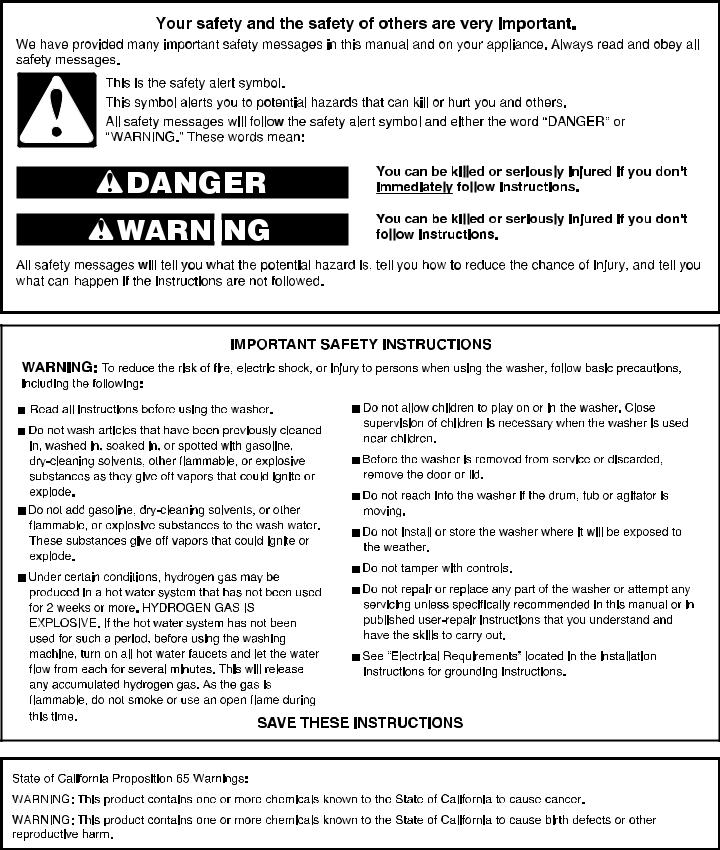
WASHER SAFETY
3
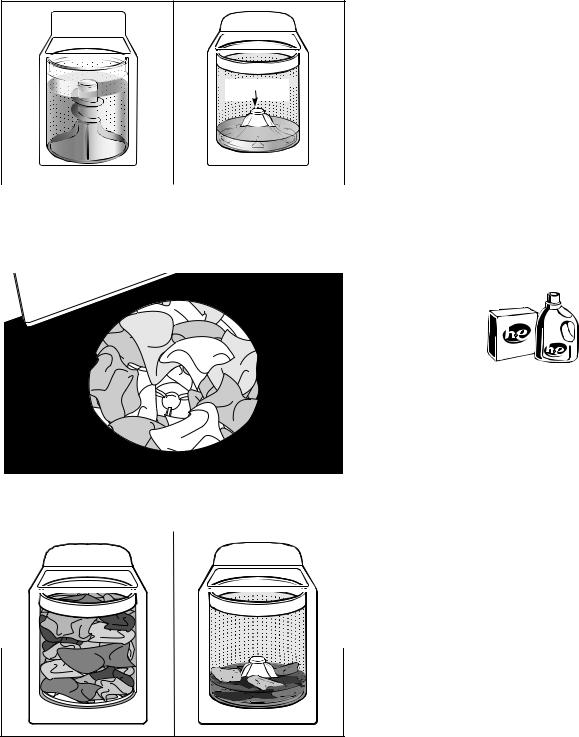
WHAT'S NEW UNDER THE LID?
Cleaning with Less Water

 Washplate
Washplate


Traditional agitator-style |
Washer with low-water |
washer |
washplate wash system |
The most striking difference in your new washer is the low-water washplate wash system. The washer automatically adjusts the water level to the load size—no water level selector is needed.
Load garments in loose heaps evenly around the washplate. Do not load garments directly over the center of the washplate; when loaded, the center of the washplate should be visible.
As the washer dampens and moves the load, the level of the garments will settle in the basket. This is normal, and does not indicate that more garments should be added.
IMPORTANT: You will not see a washer basket full of water as with your past agitator-style washer. It is normal for some of the load to be above the water line.
Automatic Load Size Sensing
Once you start the cycle, the lid will lock, and the washer will begin the sensing process to determine the correct water level for the load. This may take several minutes before water is added. You will find a step-by-step description in the “Cycle
Status Lights” section.
You will hear the motor turn the basket in short pulses to thoroughly wet the load. This low-water wash method uses less water and energy compared to a traditional agitator-style washer.
Choosing the Right Detergent
Use only High Efficiency detergents. The package will be marked “HE” or “High Efficiency.” Low-water washing creates excessive sudsing with a regular non-HE detergent. Using regular detergent will likely result in longer cycle times and reduced rinsing performance. It may also result in component failures and noticeable mold or mildew. HE detergents are made to produce the right amount of suds for the best performance. Follow the manufacturer’s instructions to determine the amount of detergent to use.
Use only High Efficiency (HE) detergent.
Concentrated Cleaning
Low-water cleaning means concentrated cleaning. Rather than diluting detergent as done in an agitator-style washer, this washer delivers the detergent directly to the soils.
Normal Sounds You Can Expect
At different stages of the wash cycle, you may hear sounds and noises that are different from those of your previous washer. For example, you may hear a clicking and hum at the beginning of the cycle, as the lid lock goes through a self-test. There will be different kinds of humming and whirring sounds as the washplate moves the load. And sometimes, you may hear nothing at all, as the washer determines the correct water level for your load or allows time for clothes to soak.
4
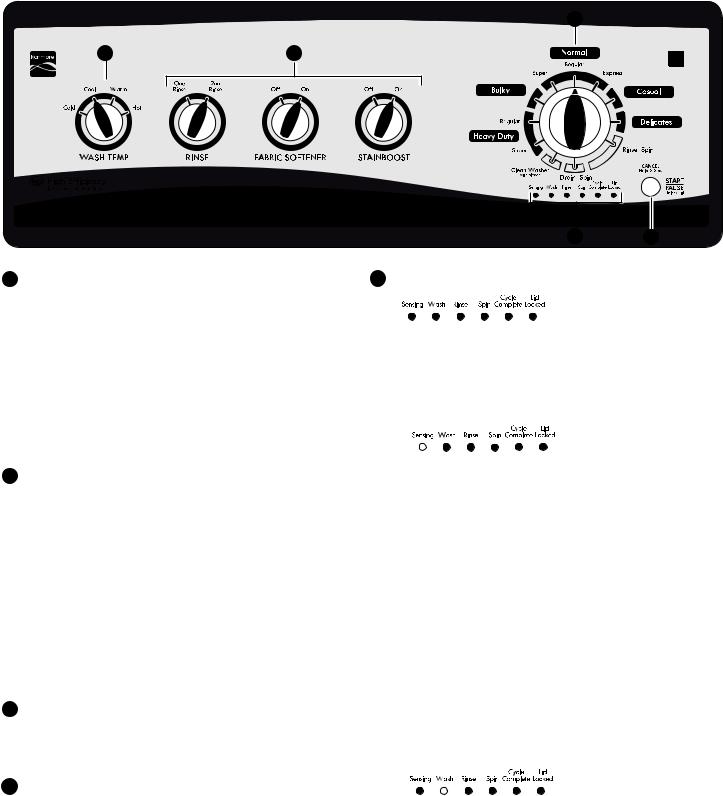
CONTROL PANEL AND FEATURES
3
1 |
2 |
5 4
1WASH TEMP
Temperature Control senses and maintains uniform water temperatures by regulating incoming hot and cold water.
Select a wash temperature based on the type of fabric and soils being washed. For best results and following the garment label instructions, use the warmest wash water safe for your fabric.
•Warm and hot water will be cooler than what previous washer provided.
•Even in a cool and cold water wash, some warm water may be added to the washer to maintain a minimum temperature.
2CYCLE OPTIONS
The following options may be added to most cycles.
See “Cycle Guide” for additional details.
RINSE
This option can be used to automatically add a second rinse to most cycles.
FABRIC SOFTENER
This option must be set to “On” if using fabric softener during a cycle. It ensures that fabric softener is added at the correct time in the rinse for even distribution.
STAINBOOST
This option provides enhanced cleaning action for tough stains. It will add additional spin and soak time to
the cycle.
3WASH CYCLE KNOB
Use the Wash Cycle knob to select available cycles on your washer. Turn the knob to select a cycle for your laundry load.
See “Cycle Guide” for detailed descriptions.
4START/PAUSE/UNLOCK LID
Press to start the selected cycle; press again to pause the cycle and unlock the lid.
NOTE: If the washer is spinning, it may take several minutes to unlock the lid. Press CANCEL Hold 3 sec. to cancel a cycle.
5 CYCLE STATUS LIGHTS
The Cycle Status Lights show the progress of a cycle. At each stage of the process, you may notice sounds or pauses that are different from traditional washers.
SENSING
When the START/PAUSE/Unlock lid is pressed, the washer will first perform a self-test on the lid lock mechanism. You will hear a click, the basket will make a slight turn, and the lid will unlock briefly before locking again.
Once the lid has locked the second time, the washer will use short, slow spins to estimate the load size. These sensing spins may take 2 to 3 minutes before water is added to the load and you may hear the hum of these spins. If the sensing light is on, then washer is working properly. You will hear the motor turn the basket in short pulses to thoroughly wet the load. The washer will then move the load briefly, pause to allow water to soak in to the load, and resume adding water. This process may
repeat until the correct amount of water has been added for the load. You may also hear water flowing through the dispenser, adding detergent to the load.
NOTE: Avoid opening the lid during sensing. The sensing process will start over when the washer is restarted. The sensing light may also come on during the Soak and Wash portions of the cycle. This is normal.
WASH
You will hear the motor and washplate moving the load. Unlike traditional washers, the load is not covered with water. Low-water cleaning means concentrated cleaning. Rather than diluting detergent as done in an agitator-style washer, this washer delivers the detergent directly to the soils. The motor sounds may change at different stages in the cycle. The wash time is determined by the selected soil level.
5
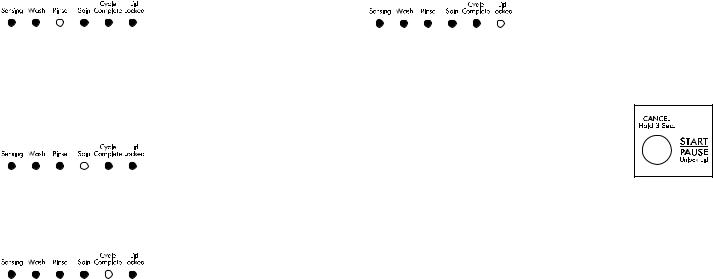
RINSE
You will hear sounds similar to the wash cycle as the washer rinses and moves the load. You may hear the motor turning on briefly (short hum) to move the basket while filling. Fabric softener will be added if the Fabric Softener-On option was selected. Some options use spray rinsing.
SPIN
The washer spins the load at increasing speeds for proper water removal, based on the selected cycle and spin speed.
CYCLE COMPLETE
Once the cycle is complete, this light will come on. Remove the load promptly for best results.
LID LOCKED
To allow for proper load sensing and spinning, the lid will lock and the Lid Locked light will turn on. This light indicates that the lid is locked and cannot be opened.
If you need to open the lid, press START/PAUSE/ Unlock Lid. The lid will unlock once the washer movement has stopped. This may take several minutes if the load was spinning at high speed. Press START/PAUSE/Unlock Lid again to resume the cycle.
6

CYCLE GUIDE
For best fabric care, choose the cycle that best fits the load being washed.
Not all cycles and options are available on all models.
Items to wash: |
Cycle: |
Wash |
Spin |
Cycle Details: |
|
|
Temp*: |
Speed: |
|
|
|
|
|
|
Sturdy fabrics, colorfast |
Heavy |
Hot |
High |
Provides maximum wash time and action for tough |
items, towels, jeans |
Duty |
Warm |
|
stains and soils. Use this cycle for heavily soiled or |
|
Super |
Cool |
|
sturdy items. Water-level sensing process may take |
|
|
Cold |
|
longer for some items than for others because they |
|
|
|
|
will absorb more water than other fabric types. |
|
|
|
|
|
Sturdy fabrics, colorfast |
Heavy |
Hot |
High |
Use this cycle for normally soiled or sturdy fabrics. |
items, towels, jeans |
Duty |
Warm |
|
Water-level sensing process may take longer for |
|
Regular |
Cool |
|
some items than for others because they will absorb |
|
|
Cold |
|
more water than other fabric types. |
|
|
|
|
|
Large items such as sheets, |
Bulky |
Hot |
Low |
Use this cycle to wash large items such as |
small comforters, sleeping |
|
Warm |
|
jackets and small comforters. The washer will fill |
bags, small washable rugs |
|
Cool |
|
with enough water to wet down the load before the |
|
|
Cold |
|
wash portion of the cycle begins, and uses a higher |
|
|
|
|
water level than other cycles. Do not tightly pack |
|
|
|
|
the basket. |
Large items such as sheets, |
Normal |
Hot |
High |
Use this cycle for heavily soiled cottons and mixed |
small comforters, jackets |
Super |
Warm |
|
fabric loads. High speed spin is the only spin speed |
|
|
Cool |
|
available for the Normal cycle. This cycle features |
|
|
Cold |
|
a spray rinse. |
|
|
|
|
|
Cottons, linens, and mixed |
Normal |
Hot |
High |
Use this cycle for normally soiled cottons and |
garment loads |
Regular |
Warm |
|
mixed fabric loads. High speed spin is the only |
|
|
Cool |
|
spin speed available for the Normal cycle. This |
|
|
Cold |
|
cycle features a spray rinse. |
|
|
|
|
|
Lightly soiled fabrics |
Normal |
Hot |
High |
Use this cycle for lightly soiled fabrics. This cycle |
|
Express |
Warm |
|
features a spray rinse. |
|
|
Cool |
|
|
|
|
Cold |
|
|
|
|
|
|
|
No-iron fabrics, cottons, |
Casual |
Hot |
Low |
Use this cycle to wash loads of no-iron fabrics such |
perm press, linens, synthetics |
|
Warm |
|
as sport shirts, blouses, casual business clothes, |
|
|
Cool |
|
permanent press, and blends. |
|
|
Cold |
|
|
|
|
|
|
|
Machine-wash silks, |
Delicates |
Hot |
Low |
Use this cycle to wash lightly soiled garments |
lingerie, washable wools |
|
Warm |
|
indicating “Machine Washable Silks” or “Gentle” |
|
|
Cool |
|
cycle on the care label. Place small items in mesh |
|
|
Cold |
|
garment bags before washing. This cycle uses a |
|
|
|
|
higher, preset water level. |
|
|
|
|
|
Swimsuits and items |
Rinse/ |
Cold |
High |
Combines a rinse and high speed spin for loads |
requiring rinsing without |
Spin |
|
|
requiring an additional rinse cycle or to complete |
detergent |
|
|
|
a load after power interruption. This cycle uses a |
|
|
|
|
higher, preset water level. Also use for loads that |
|
|
|
|
require rinsing only. |
|
|
|
|
|
Hand-wash items or |
Drain/ |
N/A |
High |
This cycle uses a spin to shorten drying times for |
dripping wet items |
Spin |
|
|
heavy fabrics or special-care items washed by |
|
|
|
|
hand. Use this cycle to drain washer after canceling |
|
|
|
|
a cycle or completing a cycle after a power failure. |
|
|
|
|
|
No clothes in washer |
Clean |
Hot |
High |
Use this cycle every 30 washes to keep the inside |
|
Washer |
|
|
of your washer fresh and clean. This cycle uses a |
|
with |
|
|
higher water level. Use with liquid chlorine bleach |
|
Bleach |
|
|
to thoroughly clean the inside of your washer. This |
|
|
|
|
cycle should not be interrupted. See “Cleaning |
|
|
|
|
Your Washer.” |
|
|
|
|
IMPORTANT: Do not place garments or other items |
|
|
|
|
in the washer during the Clean Washer with Bleach |
|
|
|
|
cycle. Use this cycle with an empty wash tub. |
|
|
|
|
|
*All rinses are cold. |
|
|
|
|
7
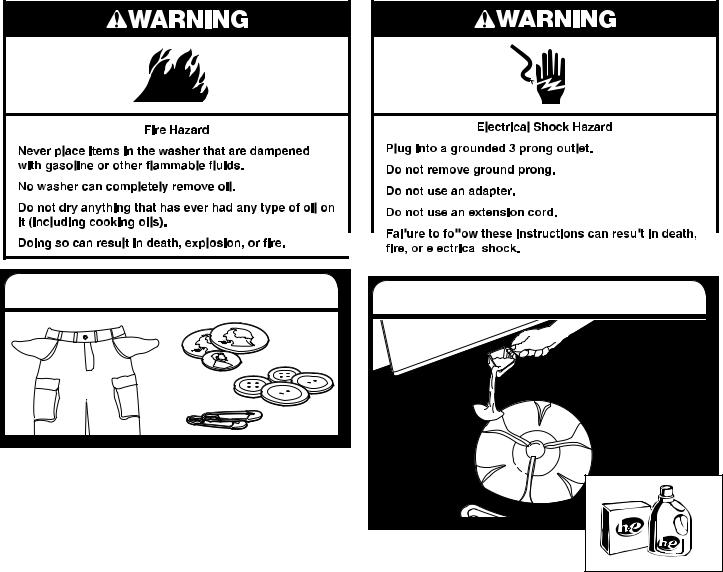
USING YOUR WASHER
1. Sort and prepare your laundry
2. Add HE detergent
•Empty pockets. Loose change, buttons, or any small object can pass under the washplate and become trapped, causing unexpected sounds.
•Sort items by recommended cycle, water temperature, and colorfastness.
•Separate heavily soiled items from lightly soiled.
•Separate delicate items from sturdy fabrics.
•Do not dry garments if stains remain after washing, because heat can set stains into fabric.
•Treat stains promptly.
•Close zippers, fasten hooks, tie strings and sashes, and remove non-washable trim and ornaments.
•Mend rips and tears to avoid further damage to items during washing.
Helpful Tips:
•When washing water-proof or water-resistant items, load evenly. See “Cycle Guide” for tips and more information on using the Bulky cycle.
•Use mesh garment bags to help avoid tangling when washing delicate or small items.
•Turn knits inside out to avoid pilling. Separate lint-takers from lint-givers. Synthetics, knits, and corduroy fabrics will pick up lint from towels, rugs, and chenille fabrics.
Always read and follow fabric care label instructions to avoid damage to your garments.
Add a measured amount of HE detergent into the basket.
IMPORTANT: Use only High Efficiency detergents. The package will be marked “HE” or “High Efficiency.” Low-water washing creates excessive sudsing with a regular non-HE detergent.
Using regular detergent will likely result in longer cycle times and reduced rinsing performance. It may also result in component failures and noticeable mold or mildew. HE detergents are made to produce the right amount of suds for the best performance. Follow the manufacturer’s instructions to determine the amount of detergent to use.
Using Oxi or color-safe bleach:
If using an Oxi or color-safe bleach laundry boost product, add to the bottom of the washer basket before adding clothes.
8
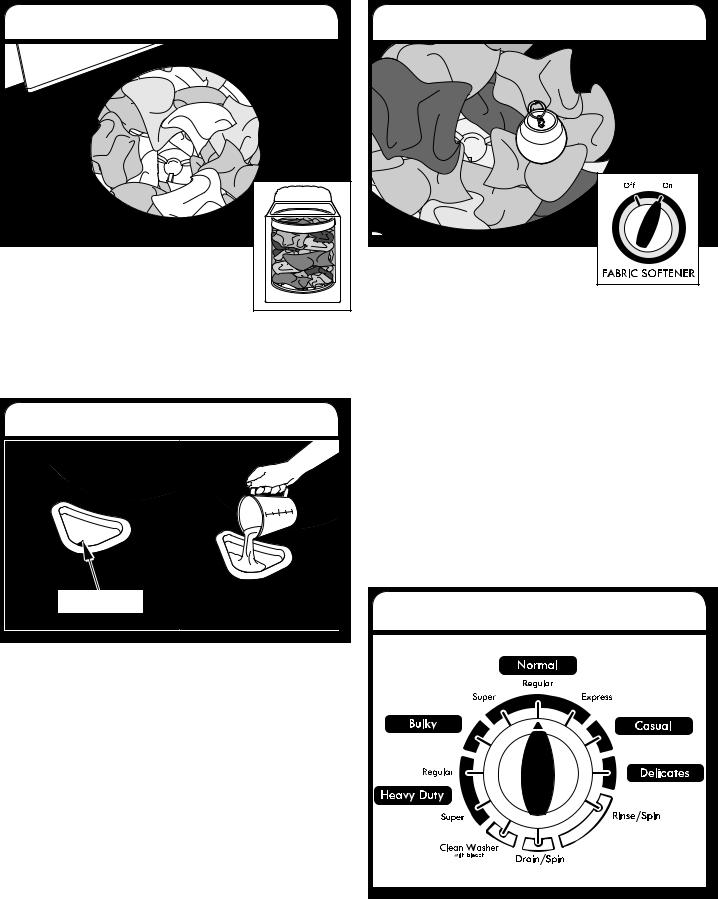
3. Load laundry into washer |
5. Add fabric softener |
Load garments in loose heaps evenly around the washplate. Do not load garments directly over the center of the washplate; when loaded, the center of the washplate should
be visible. Try mixing different sized items to reduce tangling.
IMPORTANT: Do not tightly pack or force garments into washer. Garments need to move freely. Tightly packed garments can lead to poor cleaning performance, and may increase wrinkling and tangling.
4. Add liquid chlorine bleach to dispenser
Liquid
Chlorine Bleach
Do not overfill, dilute, or use more than 1 cup (250 mL). Do not use color-safe bleach or Oxi products in the same cycle with liquid chlorine bleach.
This washer has been designed to allow the use of the Downy Ball® to dispense fabric softener in the rinse cycle. Pour a
measured amount of Downy® liquid fabric softener into the Downy Ball®, pull the ring tightly to seal it, and place on top of load. Always follow manufacturer’s directions for correct amount of fabric softener based on your load size. Then select Fabric Softener-On option. The Downy Ball® will automatically release the fabric softener during the rinse cycle. For questions on using the Downy Ball® call 1-800-688-7638 or visit www.downy.com.
IMPORTANT: Fabric Softener option must be selected to “On” to ensure proper distribution at correct time in cycle. Do not overfill or dilute.
Adding Liquid Fabric Softener Manually to Wash Load
During the final rinse, wait until the washer has completed filling, press the START/PAUSE/Unlock Lid button to pause the washer. Lift the lid and add the measured recommended amount of liquid fabric softener. Do not allow liquid fabric softener to spill, splash, drip, or run into the basket or on load. Do not use more than the recommended amount. Close the lid and press the START/PAUSE/ Unlock Lid button again to start the washer.
IMPORTANT: Fabric Softener option must be selected to “On” to ensure proper distribution of the fabric softener during the rinse portion of the cycle.
6. Select cycle
Turn cycle knob to choose your wash cycle.
9
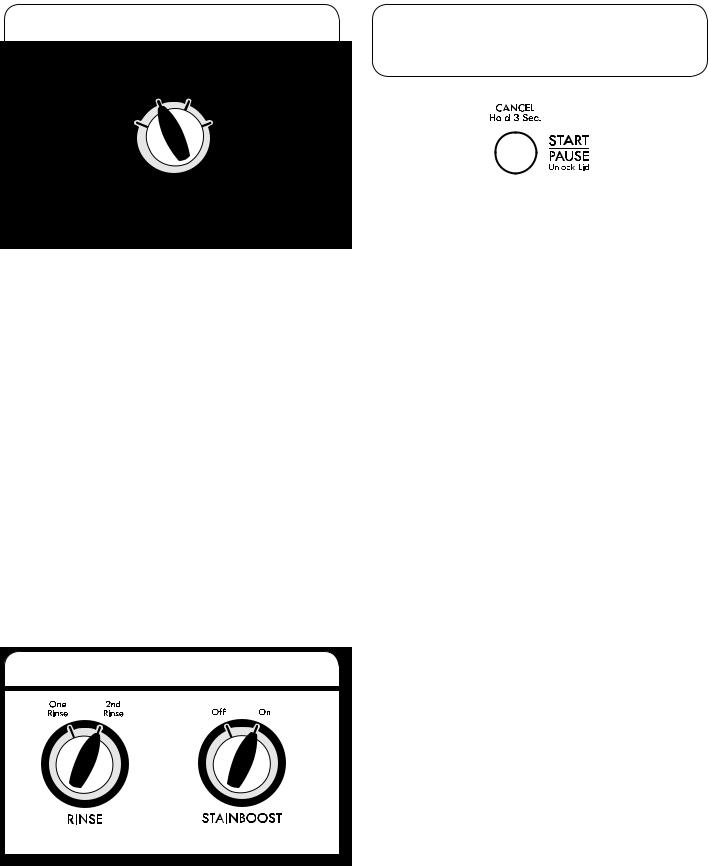
|
7. Select wash temperature |
|
|
9. Press START/Pause/Unlock Lid |
||||||||||||
|
|
|
|
|
|
|
|
|
|
to begin wash cycle |
||||||
|
|
|
|
|
|
|
|
|||||||||
|
|
|
|
|
|
|
|
|
|
|
|
|
|
|
|
|
|
|
|
|
|
|
|
|
|
|
|
|
|
|
|
|
|
|
|
|
|
|
|
|
|
|
|
|
|
|
|
|
|
|
|
|
|
|
|
|
|
|
|
|
|
|
|
|
|
|
|
|
|
|
|
|
|
|
|
|
|
|
|
|
|
|
|
|
|
|
|
|
|
|
|
|
|
|
|
|
|
|
|
|
|
|
|
|
|
|
|
|
|
|
|
|
|
|
|
|
|
|
|
|
|
|
|
|
|
|
|
|
|
|
|
|
|
|
|
|
|
|
|
|
|
|
|
|
|
|
|
|
|
|
|
|
|
|
|
|
|
|
|
|
|
|
|
|
|
|
|
|
|
|
|
|
|
|
|
|
|
|
|
|
|
|
|
|
|
|
|
|
|
|
|
|
|
|
|
|
|
|
|
|
|
|
|
|
|
|
|
|
|
|
|
|
|
|
|
|
|
|
|
|
Once you select a cycle, select the desired wash temperature by turning the Wash Temp knob to the desired setting.
Always read and follow fabric care label instructions to avoid damage to your garments.
Wash Temp |
Suggested Fabrics |
|
|
|
|
Hot |
|
|
Some cold water is added to save |
Whites and pastels |
|
energy. This will be cooler than |
Durable garments |
|
your hot water heater setting. |
||
Heavy soils |
||
|
||
|
|
|
Warm |
|
|
Some cold water will be added, so |
Bright colors |
|
this will be cooler than what your |
Moderate to light soils |
|
previous washer provided. |
||
|
||
|
|
|
Cool |
|
|
Warm water is added to assist in |
Colors that bleed |
|
soil removal and to help dissolve |
or fade |
|
detergents. |
Light soils |
|
|
||
|
|
|
Cold |
|
|
Warm water is added to assist in |
Dark colors that |
|
soil removal and to help dissolve |
bleed or fade |
|
detergents. |
Light soils |
|
|
8. Select cycle options, if desired
If you would like to add a 2nd Rinse and/or use the STAINBOOST option, turn the knob for that feature.
The STAINBOOST option provides enhanced cleaning action for tough stains. It will add additional agitation and soak time to the cycle.
Press the START/PAUSE/Unlock Lid button to start the wash cycle. Filling is delayed for several minutes while load balance is sensed. When the cycle has finished, the CYCLE COMPLETE indicator will light. Promptly remove garments after cycle has completed to avoid odor, reduce wrinkling, and rusting of metal hooks, zippers, and snaps.
Unlocking the lid to add garments
If you need to open the lid to add 1 or 2 missed garments:
Press START/PAUSE/Unlock Lid; the lid will unlock once the washer movement has stopped. This may take several minutes if the load was spinning at high speed. Then close lid and press START/PAUSE/Unlock Lid again to restart the cycle.
If lid is left open for more than 10 minutes, the water will pump out automatically.
Delay in water fill
Filling is delayed for 2 to 3 minutes to check for load unbalance. You will hear the hum of the spin prior to filling.
This is normal operation.
10
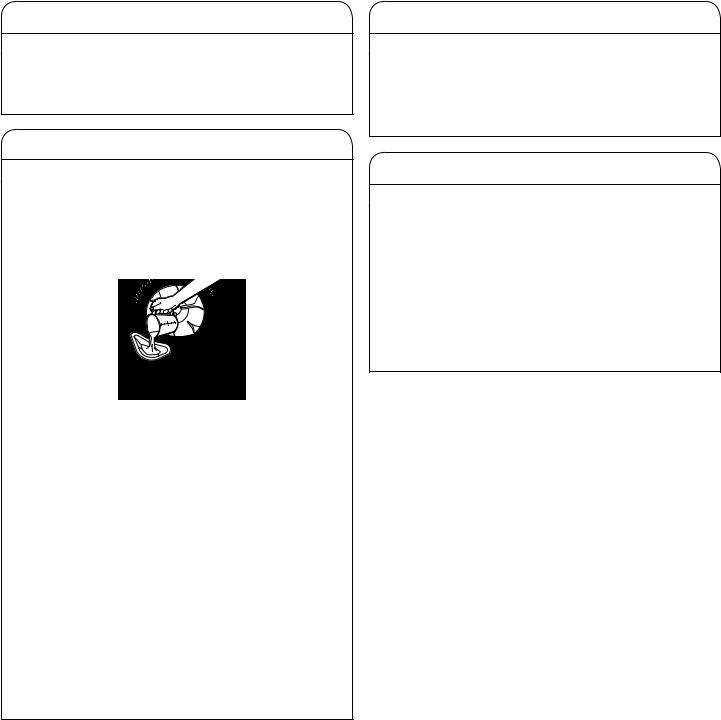
WASHER MAINTENANCE
WATER INLET HOSES
Replace inlet hoses after 5 years of use to reduce the risk of hose failure. Periodically inspect and replace inlet hoses if bulges, kinks, cuts, wear, or leaks are found.
When replacing your inlet hoses, mark the date of replacement on the label with a permanent marker.
CLEANING YOUR WASHER
Keep your washer as clean and fresh as your clothes.
To keep washer interior odor-free, follow this recommended cleaning procedure every 30 washes:
1.Make sure the washer is empty.
2.Using liquid chlorine bleach, add 1 cup (250 mL) to liquid chlorine bleach dispenser.
IMPORTANT: Do not add detergent to CLEAN WASHER with bleach cycle. Do not use more than recommended amount of bleach to avoid damaging product over time.
3.Close washer lid.
4.Select CLEAN WASHER with bleach cycle.
5.Select HOT Wash Temp.
6.Press START/PAUSE/Unlock Lid.
NOTE: For best results, do not interrupt cycle. If cycle must be interrupted, Press and Hold START/PAUSE/Unlock Lid for three seconds and run a RINSE/SPIN cycle to ensure bleach has been rinsed from washer.
Cleaning the bleach dispenser
Wipe the inside of the bleach dispenser with a clean, damp cloth.
To clean exterior:
1.Use a soft, damp cloth or sponge to wipe up any spills.
2.Use all-purpose surface cleaner, if needed.
IMPORTANT: To avoid damaging the washer’s finish, do not use abrasive products.
NON-USE AND VACATION CARE
Operate your washer only when you are home. If moving, or not using your washer for a period of time, follow these steps:
1.Unplug or disconnect power to washer.
2.Turn off water supply to washer, to avoid flooding due to water pressure surge.
WINTER STORAGE CARE
IMPORTANT: To avoid damage, install and store washer where it will not freeze. Because some water may stay in hoses, freezing can damage washer. If storing or moving during freezing weather, winterize your washer.
To winterize washer:
1.Shut off both water faucets; disconnect and drain water inlet hoses.
2.Put 1 qt. (1 L) of R.V.-type antifreeze in basket and run washer on RINSE/SPIN cycle for about 30 seconds to mix antifreeze and remaining water.
3.Unplug washer or disconnect power.
11
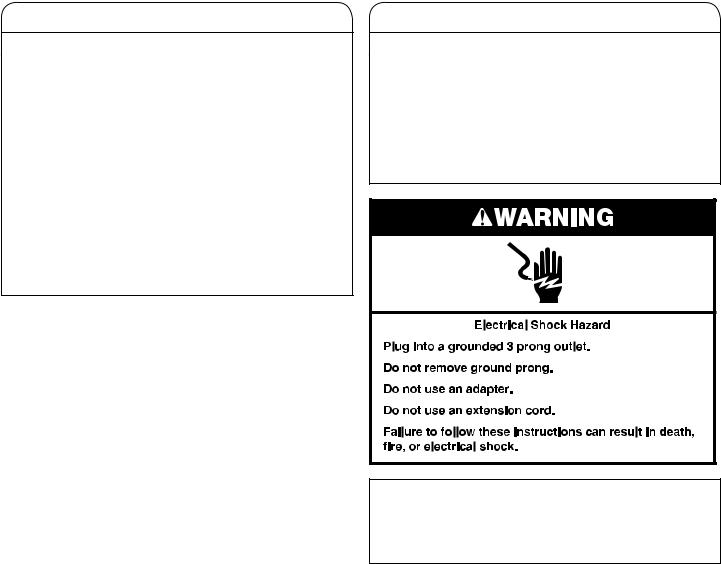
TRANSPORTING YOUR WASHER
1.Shut off both water faucets. Disconnect and drain water inlet hoses.
2.If washer will be moved during freezing weather, follow WINTER STORAGE CARE directions before moving.
3.Disconnect drain from drain system and drain any remaining water into a pan or bucket. Disconnect drain hose from back of washer.
4.Unplug power cord.
5.Place inlet hoses and drain hose inside washer basket.
6.Drape power cord over edge and into washer basket.
7.Place packing tray from original shipping materials back inside washer. If you do not have packing tray, place heavy blankets or towels into basket opening. Close lid and place tape over lid and down front of washer. Keep lid taped until washer is placed in new location.
REINSTALLING/USING WASHER AGAIN
To reinstall washer after non-use, vacation, winter storage, or moving:
1.Refer to Installation Instructions to locate, level, and connect washer.
2.Before using again, run washer through the following recommended procedure:
To use washer again:
1.Flush water pipes and hoses. Reconnect water inlet hoses. Turn on both water faucets.
2.Plug in washer or reconnect power.
3.Run washer through BULKY cycle to clean washer and remove antifreeze, if used. Use only HE High Efficiency detergent. Use 1/2 the manufacturer’s recommended amount for a medium-size load.
12

TROUBLESHOOTING
13

TROUBLESHOOTING
14

TROUBLESHOOTING
15

TROUBLESHOOTING
16
